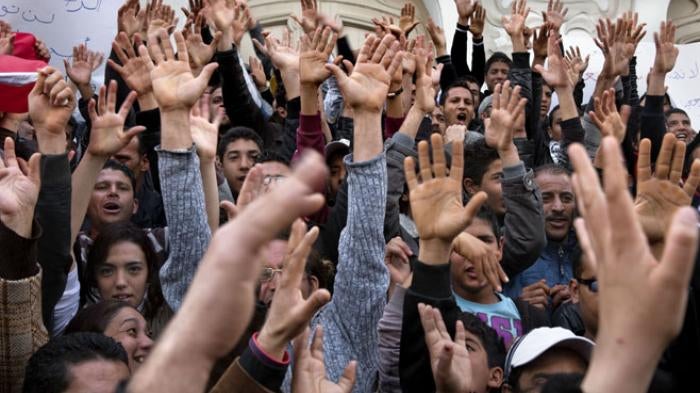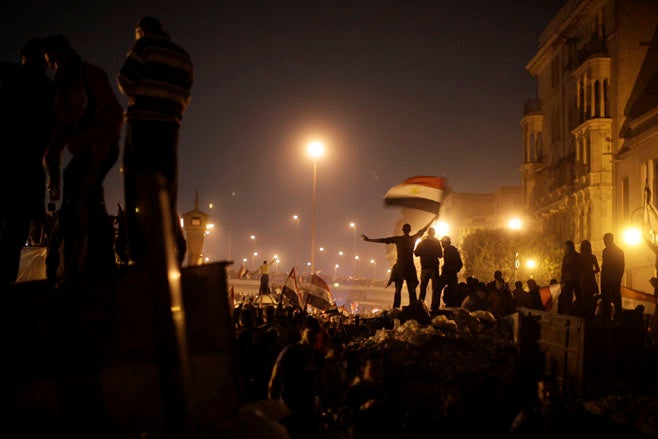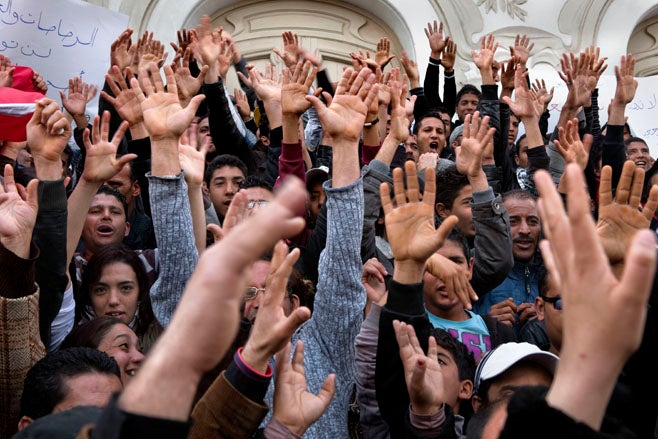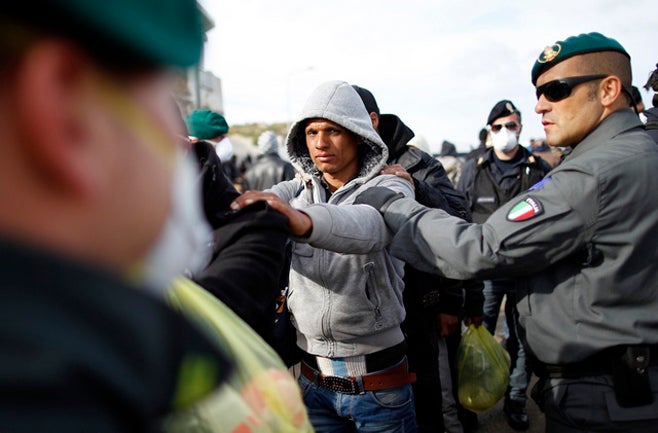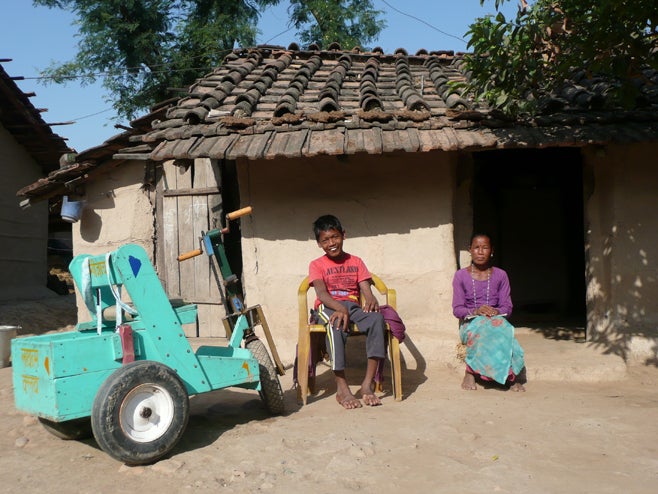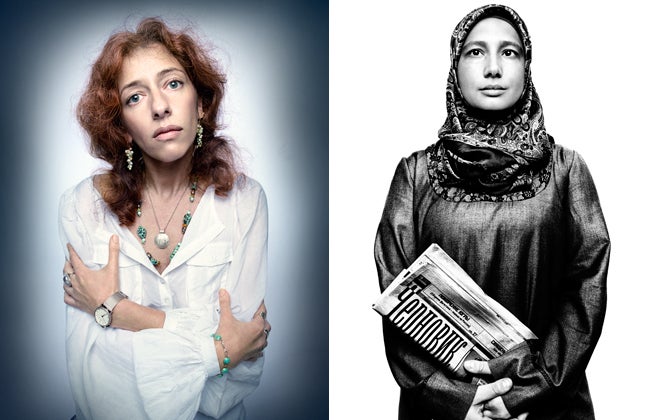By Eric Goldstein
Like everyone else, we didn’t see it coming.
Even though we human rights workers spent much time scrutinizing the Middle East and North Africa from the bottom up, talking to the disenfranchised, the oppressed, and the stubbornly defiant, the timing and extent of the popular revolts that shook the region in 2011 surprised us as much as they did policy-makers, scholars, diplomats, and journalists.
Why didn’t we see the upheavals coming? One reason was because we overestimated the robustness of some of the authoritarian regimes, and underestimated demands for a better life, measured partly in human rights terms. Yes, we heard a lot about the hogra, an Algerian term used throughout North Africa to denote the contempt of rulers toward their people. But we failed to see how quickly it could ignite into a region-wide revolt that is, in large part, a struggle for dignity.
It’s a concept that is, of course, central to the human rights enterprise. The Universal Declaration of Human Rights leads with the assertion that “recognition of the inherent dignity....” of human beings is the “foundation of freedom, justice and peace in the world.” The Koran says that God has “dignified humankind,” while contemporary philosophers have reflected on the link between dignity and human rights. Martha Nussbaum, for example, writes that all persons “are of equal dignity and worth.” The primary source of these values, she says, is a power of moral choice within them that gives them a fair claim to certain types of treatment from society and politics. “This treatment must … respect and promote the liberty of choice, and … respect and promote the equal worth of persons as choosers,” she states.
The notion of dignity is so central to human rights that it had—for me at least—become an abstraction until the Arab Spring protests forced me to reflect on its meaning. Long before Tunisian peddler Mohamed Bouazizi set himself ablaze on December 17, 2010, to protest a humiliating run-in that day with local police—igniting unrest that ousted President Zine el-Abidine Ben Ali one month later and spread as far as Syria, Bahrain, and Yemen—there were countless, equally poignant protests against indignity that passed unnoticed. But they added to the pent-up frustrations that gave resonance to Bouazizi’s desperate act.
In 2004, for example, Slaheddine Aloui, a Tunisian agricultural engineer recently freed from 14 years in jail for political activity sat down in a local market holding a sign that offered, with Swiftian irony, to sell his daughters. The Ben Ali government had prevented him from supporting his family by pressuring employers not to hire ex-political prisoners and had imposed a 16-year sentence of post-prison “administrative control” that subjected him to onerous and time-consuming sign-in requirements.
This quest for dignity, including the right to self-governance, was evident throughout Tunisia on election day, October 23, 2011, as more than 80 percent of registered voters joined long lines to vote in the country’s first free election, in this case for a constituent assembly that will write a constitution. “It’s the first time I’ve waited on line for three hours for anything and am smiling,” one voter told me.
And it was the demand for dignity that propelled a depoliticized Egyptian middle class into action, as Ramez Mohamed, a 26-year-old computer science graduate who works in telecommunications told The New York Times in February 2011:
… the [government’s] websites’ blockade and communications blackout on January 28 was one of the main reasons I, and many others, were pushed to the streets…. Imagine sitting at your home, having no single connection with the outer world. I took the decision, “This is nonsense, we are not sheep in their herd.” I went down and joined the protests.
For many Libyans, dignity came via a rebellion that showed the world, “We are not Gaddafi”—the leader with whom the country had been synonymous for four decades—but rather a people able to shape its own destiny.
We failed to predict the Arab Spring was because we were more focused on supply than demand when it came to human rights; that is, we were more attuned to the extent to which governments supplied (or did not supply) the chance to exercise basic rights than we were with the pent-up demand of people to exercise those rights, despite the risks involved.
We tended to see mainly the authoritarian governments, whose grip was never in doubt, even when they tolerated a controlled pluralism, cautiously independent print media, and a fragile civil society. What we undervalued were rising expectations on the demand side, which subsequently fired the 2011 upheavals, during which thousands of peaceful demonstrators gave their lives in Tunisia, Egypt, Libya, Syria, Yemen, and Bahrain.
In some sense it was an understandable error in emphasis. After all, at the start of the year most Arab societies had lived under repressive rulers for decades. Less apparent was the human rights activism and economic and political protest that had been slowly growing in many Arab countries during the previous decade.
For example, in Egypt, the Kefaya (Enough) movement emerged in 2004, mixing street protests and online activism to oppose a new term for President Hosni Mubarak and the grooming of his son as successor. Labor strife in Egypt intensified; in April 2008, police repression of a textile workers strike in Mahalla al-Kubra killed four people. A Facebook group called the April 6 Youth Movement was formed in solidarity with Mahalla, which grew quickly to tens of thousands of members, many of them young and educated with no history of political activism. The movement was among the key organizers of the Tahrir Square protest that began on January 25, 2011.
It was a similar story in Tunisia, where in 2008 protests convulsed the forlorn Gafsa region, where the poor and unemployed filled the streets to oppose nepotistic hiring by the state mining company. When police responded with mass arrests and torture, a gutsy solidarity network of union, political party, and human rights activists formed to support the Gafsa victims. While President Ben Ali’s government ultimately crushed the Gafsa protests and prevented their supporters from gaining steam, the combination of grassroots protest in the disenfranchised inland and the solidarity movement in the north now seems a dress rehearsal for the regime-changing uprising of December 2010 and January 2011.
Following the unification of North and South Yemen in 1990, civil society blossomed and was largely able to resist efforts since 2007 by President Ali Abdullah Saleh, who has ruled since 1978, to clamp down on independent media and associations. In early 2011, civil society leaders had become a key force in the protests calling for the president’s exit. (The anti-Saleh movement gained force also from Huthi rebels in the north and separatists in the south, which both allege discrimination by the central government, and from a renegade military brigade and tribal militias.)
Even in Syria and Libya—where the governments were among the region’s most brutal—human rights contestation picked up during the past decade. In the former, the “Damascus Spring” reform movement and the Committees for the Revival of Civil Society that launched shortly after Bashar al-Asad succeeded his father as president in 2000, as well as the Damascus Declaration of 2005, displayed a new assertiveness by small groups of Syrians demanding basic rights, although many wound up serving long prison terms. And in Libya, families of victims of the 1996 mass killings in Abu Salim prison became the first group in the country to demonstrate regularly in public after a North Benghazi court in 2008 ordered the government to reveal the fate of Abu Salim prisoners who had “disappeared.”
In addition to such frontal defiance, subtler strands of opposition were also forming.
In Tunisia, sympathizers with the cause of human rights who had demobilized in the early and mid-1990s under pressure from Ben Ali’s government re-emerged in the 2000s. In 2001, for example, we found a journalism professor attending events organized by the Tunisian Human Rights League and briefing foreign visitors on the lack of media freedom; just five years earlier, he had declined to meet with Human Rights Watch because he feared questioning and surveillance by the secret police. Families of political prisoners, who had just a few years earlier shunned contact with international human rights groups fearing reprisals against themselves or their loved ones, now sought out such organizations and strove to publicize the plight of imprisoned relatives.
What had changed?
For the professor it was a newfound sense that civil society had been paralyzed too long and it was time to take a stand. For the families of political prisoners,it was the realization that by remaining silent they had gained nothing and that with their relatives still in prison, there was nothing left to lose. As a result, around the core of diehard activists there formed an outer circle of people willing to take a stand, if somewhat more discreetly, on some human rights issues.
These shifts were reinforced by the spread of new communication technologies that connected activists, in real time and at minimal expense, with domestic and international audiences. Able to exchange information and opinions securely and anonymously, their link to larger networks encouraged activists to persevere despite repression. It also encouraged them to formulate their demands for change in terms of human rights, a universal and nonpartisan framework that their audience could endorse whatever their political orientation.
At the same time, governments started to recognize that they could not ignore their human rights image. Leaders who had once tried to discredit human rights as a Western concept alien to local culture began in the 1990s to create and promote their own human rights commissions.
By 2000 such commissions operated in nearly every country in the region. In practice, most of them put a positive spin on the government’s record while trying to divert attention from violations. The point here is not the objectivity of such commissions; rather, the fact that they reflect governments’ recognition of human rights as a critical factor by which they were being judged, both domestically and internationally.
Another indicator of human rights awareness in these countries was the remarkably high number of victims or witnesses who agreed to provide evidence to human rights investigators. When seeking people’s accounts about, say, torture and unjust imprisonment, our researchers explain that we are preparing a public report to expose abuses and pressure the government to clean up its act. Given how little we can promise victims and witnesses, it is surprising and moving how consistently they agreed to tell their stories. Narrating their experiences gave them a sense of dignity or of honoring victims, reframing what might otherwise be a random, local act of cruelty and injustice as a human rights event that fit an international framework built on treaties their government had committed to respect. Testifying about an unlawful killing also connected families to one other, establishing patterns of abuse that undermined governments’ efforts to minimize violations by misrepresenting them as isolated events.
The year’s events remind us that asserting one’s rights against repressive governments does not mean embracing all rights for all people. Human rights demands may have energized the protests that shook the Middle East and North Africa in 2011. But protecting rights, especially for vulnerable sectors of the population, remains an uphill battle in the countries where authoritarian rulers have toppled, not just in those where they still rule.
In the months since Ben Ali and Mubarak fell from power, for example, women demonstrating in Tunisia and Egypt to demand gender equality have been slapped, groped, or threatened by counter-demonstrators. Protesters in Tunis ransacked a cinema in June and burned a television executive’s home in October to protest programming they deemed insulting to Islam. In Libya rebels have mistreated thousands of sub-Saharan African migrant workers on the pretext that they were mercenaries for Muammar Gaddafi. And in Egypt deadly sectarian violence has cast a pall over the Muslim-Christian unity seen during the anti-Mubarak protests.
This newly volatile region is likely to bring more surprises in 2012. Just as rising expectations for a dignified life shook several governments of the region in 2011, they may yet motivate revolts against successor governments, in Tunisia or elsewhere, should those governments fall short in this regard. We didn’t see the Arab Spring coming because we missed signs of the thaw. But we would do well to keep in mind what Arab peoples showed us about the power of the aspiration for dignity, a power that they are unlikely to surrender anytime soon.
